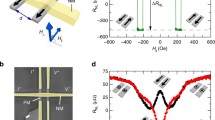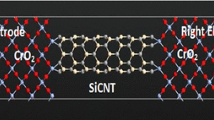Abstract
Inversion asymmetry at an interface separating two different metals can produce a strong interfacial Rashba spin–orbit coupling (ISOC) that induces various charge and spin transport phenomena. For the sake of analyzing such emergent phenomena in a ballistic approximation, we consider a simple model of a metallic system of two interfaces with strong spin–orbit coupling. We show that the ISOC would be responsible for inducing a z-dependent and z-independent secondary lateral charge currents from the primary spin current injected in the system (spin-charge current conversion), where the z-direction corresponds to the direction of flow of the primary spin current. We explain the fundamental background behind this induction in terms of quantum interference effects. Furthermore, we show that the presence of a tunneling barrier between the two interfaces increases spin current attenuation, but reduces it once the width of the tunneling barrier becomes sufficiently large.




Similar content being viewed by others
Data Availability Statement
This manuscript has no associated data or the data will not be deposited. [Authors’ comment: This is a theoretical study, and no experimental data has been listed.]
References
S. Wolf, D. Awschalom, R. Buhrman, J. Daughton, S. Von Molnar, M. Roukes, A.Y. Chtchelkanova, D.D. Treger, Science 294, 1488 (2001)
I. Žutić, J. Fabian, S.D. Sarma, Rev. Mod. Phys. 76, 323 (2004)
M. Johnson, R.H. Silsbee, Phys. Rev. Lett. 55, 1790 (1985)
P. Van Son, H. Van Kempen, P. Wyder, Phys. Rev. Lett. 58, 2271 (1987)
E. Šimánek, B. Heinrich, Phys. Rev. B 67, 144418 (2003)
D. Mills, Phys. Rev. B 68, 014419 (2003)
Y. Tserkovnyak, A. Brataas, G.E. Bauer, B.I. Halperin, Rev. Mod. Phys. 77, 1375 (2005)
A. Brataas, G.E. Bauer, P.J. Kelly, Phys. Rep. 427, 157 (2006)
S. Zhang, Z. Li, Phys. Rev. Lett. 93, 127204 (2004)
L. Gravier, S. Serrano-Guisan, F. Reuse, J.-P. Ansermet, Phys. Rev. B 73, 024419 (2006)
O. Tsyplyatyev, O. Kashuba, V.I. Fal’ko, Phys. Rev. B 74, 132403 (2006)
M. Hatami, G.E. Bauer, Q. Zhang, P.J. Kelly, Phys. Rev. Lett. 99, 066603 (2007)
A. Takeuchi, K. Hosono, G. Tatara, Phys. Rev. B 81, 144405 (2010)
W. Lin, K. Chen, S. Zhang, C. Chien, Phys. Rev. Lett. 116, 186601 (2016)
M.I. Dyakonov, V. Perel, Phys. Lett. A 35, 459 (1971)
M. D’yakonov, V. Perel, Soviet J. Exp. Theor. Phys. Lett. 13, 467 (1971)
A. Aronov, Y.B. Lyanda-Geller, Soviet J. Exp. Theor. Phys. Lett. 50, 431 (1989)
V.M. Edelstein, Sol. State Commun. 73, 233 (1990)
J. Hirsch, Phys. Rev. Lett. 83, 1834 (1999)
S. Zhang, Phys. Rev. Lett. 85, 393 (2000)
S. Murakami, N. Nagaosa, S.-C. Zhang, Science 301, 1348 (2003)
J. Sinova, D. Culcer, Q. Niu, N. Sinitsyn, T. Jungwirth, A.H. MacDonald, Phys. Rev. Lett. 92, 126603 (2004)
W.-K. Tse, J. Fabian, I. Žutić, S.D. Sarma, Phys. Rev. B 72, 241303 (2005)
R. Raimondi, C. Gorini, P. Schwab, M. Dzierzawa, Phys. Rev. B 74, 035340 (2006)
D. Culcer, R. Winkler, Phys. Rev. Lett. 99, 226601 (2007)
E. Hankiewicz, G. Vignale, J. Phys. Cond. Matter 21, 253202 (2009)
G. Vignale, J. Superconduct. Novel Magn. 23, 3 (2010)
T. Kuschel, G. Reiss, Nat. Nanotechnol. 10, 22 (2015)
G. Chen, Nat. Phys. 13, 112 (2017)
D.C. Vaz, A. Barthélémy, M. Bibes, Jpn. J. Appl. Phys. 57, 0902A4 (2018)
R. Mishra, F. Mahfouzi, D. Kumar, K. Cai, M. Chen, X. Qiu, N. Kioussis, H. Yang, Nat. Commun. 10, 1 (2019)
M. Kazemi, M.F. Bocko, Sci. Rep. 9, 1 (2019)
J.J. He, K. Hiroki, K. Hamamoto, N. Nagaosa, Commun. Phys. 2, 1 (2019)
Y.K. Kato, R.C. Myers, A.C. Gossard, D.D. Awschalom, Science 306, 1910 (2004)
Y. Kato, R. Myers, A. Gossard, D. Awschalom, Phys. Rev. Lett. 93, 176601 (2004)
A.Y. Silov, P. Blajnov, J. Wolter, R. Hey, K. Ploog, N. Averkiev, Appl. Phys. Lett. 85, 5929 (2004)
M.B. Lifshits, M.I. Dyakonov, Phys. Rev. Lett. 103, 186601 (2009)
E. Saitoh, M. Ueda, H. Miyajima, G. Tatara, App. Phys. Lett. 88, 182509 (2006)
S. Ganichev, E. Ivchenko, V. Bel’Kov, S. Tarasenko, M. Sollinger, D. Weiss, W. Wegscheider, W. Prettl, Nature 417, 163 (2002)
C.R. Ast, J. Henk, A. Ernst, L. Moreschini, M.C. Falub, D. Pacilé, P. Bruno, K. Kern, M. Grioni, Phy. Rev. Lett. 98, 186807 (2007)
L. Moreschini, A. Bendounan, H. Bentmann, M. Assig, K. Kern, F. Reinert, J. Henk, C. Ast, M. Grioni, Phys. Rev. B 80, 035438 (2009)
S. Mathias, A. Ruffing, F. Deicke, M. Wiesenmayer, I. Sakar, G. Bihlmayer, E. Chulkov, Y.M. Koroteev, P. Echenique, M. Bauer et al., Phys. Rev. Lett. 104, 066802 (2010)
A. Shikin, A. Rybkina, A. Korshunov, Y.B. Kudasov, N. Frolova, A. Rybkin, D. Marchenko, J. Sánchez-Barriga, A. Varykhalov, O. Rader, N. J. Phys. 15, 095005 (2013)
A. Rybkin, A. Shikin, V. Adamchuk, D. Marchenko, C. Biswas, A. Varykhalov, O. Rader, Phys. Rev. B 82, 233403 (2010)
Z. Wang, D.-K. Ki, H. Chen, H. Berger, A.H. MacDonald, A.F. Morpurgo, Nat. Commun. 6, 1 (2015)
J. Okabayashi, Y. Miura, H. Munekata, Sci. Rep. 8, 1 (2018)
T. Yu, B. Deng, L. Zhou, P. Chen, Q. Liu, C. Wang, X. Ning, J. Zhou, Z. Bian, Z. Luo et al., ACS Appl. Mater. Interfaces 11, 44837 (2019)
G. Wu, Y. Ren, X. He, Y. Zhang, H. Xue, Z. Ji, Q. Jin, Z. Zhang, Phys. Rev. Appl. 13, 024027 (2020)
I. Martínez, P. Högl, C. González-Ruano, J.P. Cascales, C. Tiusan, Y. Lu, M. Hehn, A. Matos-Abiague, J. Fabian, I. Žutić et al., Phys. Rev. Appl. 13, 014030 (2020)
J. Borge, I. Tokatly, Phys. Rev. B 96, 115445 (2017)
M. Julliere, Phys. Lett. A 54, 225 (1975)
T. Matsuyama, C.-M. Hu, D. Grundler, G. Meier, U. Merkt, Phys. Rev. B 65, 155322 (2002)
Z.-G. Zhu, G. Su, B. Jin, Q.-R. Zheng, Phys. Lett. A 306, 249 (2003)
M. Lee, M.-S. Choi, Phys. Rev. B 71, 153306 (2005)
Z. Zhu, G. Su, Sci. China Phys. Mech. Astron. 56, 166 (2013)
C. Morari, W.H. Appelt, A. Östlin, A. Prinz-Zwick, U. Schwingenschlögl, U. Eckern, L. Chioncel, Phys. Rev. B 96, 205137 (2017)
T. Yokoyama, Phys. Rev. B 87, 241409 (2013)
L. Ni, Z. Chen, X. Lu, Y. Yan, L. Jin, J. Zhou, W. Yue, Z. Zhang, L. Zhang, W. Wang et al., Appl. Phys. Lett. 117, 112402 (2020)
X. Zhou, Z. Zhang, C.-Z. Hu. arXiv preprint arXiv:0904.3796 (2009)
Z. An, F. Liu, Y. Lin, C. Liu, Sci. Rep. 2, 1 (2012)
E.I. Rashba, Phys. Rev. B 68, 241315 (2003)
A. Rückriegel, P. Kopietz, Phys. Rev. B 95, 104436 (2017)
J. Wang, B. Wang, W. Ren, H. Guo, Phys. Rev. B 74, 155307 (2006)
Q.-F. Sun, X. Xie, Phys. Rev. B 72, 245305 (2005)
P.-Q. Jin, Y.-Q. Li, F.-C. Zhang, J. Phys. A Math. Gen. 39, 7115 (2006)
I. Tokatly, E. Krasovskii, G. Vignale, Phys. Rev. B 91, 035403 035403 (2015)
S. Takahashi, S. Maekawa, J. Phys. Soc. Jpn. 77, 031009 (2008)
T. Valet, A. Fert, Phys. Rev. B 48, 7099 (1993)
G. Wysin, Department of Physics, Kansas State University, Manhattan, KS 66506, 2601
Author information
Authors and Affiliations
Contributions
Amjad Sharafeddine mainly developed the theoretical formalism, performed the analytic calculations, carried out the numerical simulations, and interpreted and concluded the results. Dr. A. A. Kordbacheh supervised the project and gave valuable notes on the structure of the paper.
Corresponding author
Appendix A: Obtaining the scattering coefficients
Appendix A: Obtaining the scattering coefficients
We have assumed that V(z) is equal to \( V\Big (\theta (z+a)-\theta (z-a)\Big )\) (see Eq. (3)). Hence, \(V'(z)=V(\delta (z+a)-\delta (z-a))\).
We can let
and
It can be noticed from the Hamiltonian in Eq. (1) that the scattering problem is composed of two problems, one that corresponds to the potential \(V_{1}(z)\) which is the step potential problem and other that corresponds to the potential \(V_\mathrm{RSOC}(z)\) which is the dirac-delta potential localized at the interfaces. To obtain the energy eigenfunctions of \({\hat{H}}\), we first solve the common step potential problem, which gives us the eigenfunctions in Sect. 2.2, but by modifying and adding an additional terms to the scattering coefficients obtained in case \(V_\mathrm{RSOC}=0 (r_0, t_0, r_1, t_1).\)
In our case, the additional terms corresponding to \(r_0\) and \(t_0\) are \(\vec {{\mathbf {r}}} \cdot \vec {\sigma }\) and \(\vec {{\mathbf {t}}} \cdot \vec {\sigma }\), respectively. While the additional terms corresponding to \(r_1\) and \(t_1\) are \(\vec {{\mathbf {r}}}_1 \cdot \vec {\sigma }\) and \(\vec {{\mathbf {t}}}_1 \cdot \vec {\sigma }\), respectively. The exact form of the scattering coefficients \(({\hat{r}}_k, {\hat{t}}_k, {\hat{t}}_{1k}\) and \({\hat{r}}_{1k})\) in terms of the wavevector k of the electron is obtained by making the energy eigenfunctions obey to the boundary conditions imposed by the dirac-delta potential term \(V_\mathrm{RSOC}(z)\).
The boundary conditions are:
-
1.
\(\phi _{k\sigma }(z)\) is continuous along z.
-
2.
\( \dfrac{d\phi _{k\sigma }(z)}{dz}\Big |_{z=\pm a}=-2m\Gamma \phi _{k}(\pm a),\)
where, \(V_\mathrm{RSOC}=-\Gamma V(\delta (z+a)-\delta (z-a))\).
By handling the boundary conditions above, the x and y terms of the SOC-part of the transmission and reflection coefficients can be written in the following form:
The functions \(\chi _{1/2}, {\mathcal {M}}, {\mathcal {F}}, {\mathcal {A}}, {\mathcal {B}}\) and \({\mathcal {C}}\) are just formulated for the sake of simplifying Eq. (7) and they have the following form:
Rights and permissions
About this article
Cite this article
Sharafeddine, A., Kordbacheh, A.A. Ballistic spin transport through a metallic system of two junctions with strong spin–orbit coupling. Eur. Phys. J. B 94, 168 (2021). https://doi.org/10.1140/epjb/s10051-021-00184-x
Received:
Accepted:
Published:
DOI: https://doi.org/10.1140/epjb/s10051-021-00184-x




